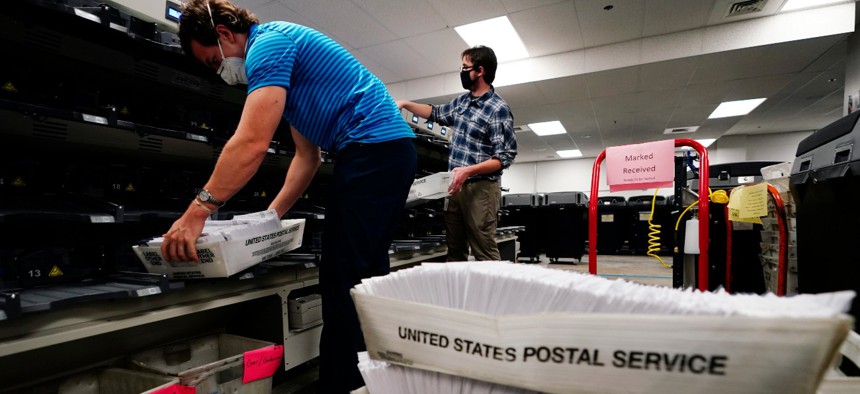USPS Blames Pandemic for Pockets of Slowed Ballot Processing as Employee Coronavirus Cases Spike
Postal Service says widespread delays for mail in general are attributable to emphasis on ballots.
Delayed processing for mail-in ballots has spiked in many areas around the country, according to U.S. Postal Service data. The agency primarily cited unavailability of employees due to the novel coronavirus pandemic as the reason for the slowdowns.
Nearly 3,600 USPS employees are currently infected with COVID-19, while another 4,500 are in quarantine. That amounts to about 1.3% of the Postal Service’s 630,000-person workforce, enough to impact operations in some areas. The number of current infections marks a nearly 50% increase from Oct. 1, according to data from the National Mail Handlers Union, when 2,471 employees tested or were presumed positive. All told, about 15,000 postal employees have contracted COVID-19.
On Monday, the day before Election Day, on-time processing of trackable mailed ballots on their way from voters to election boards dropped below 90% for the first time since USPS began reporting daily data. Election Day serves as the deadline for ballots to be postmarked in some states and for ballots to be received by boards of election in others.
Eleven districts across the country saw more than 10% of inbound ballots experience processing delays on both Oct. 30 and 31, or more than 20% just on Oct. 31. In several of those districts, such as Colorado/Wyoming, central Pennsylvania and greater Michigan, USPS blamed employee unavailability due to COVID-19.
Postal management told a federal court in Washington, D.C., it was moving employees around from other facilities, maximizing overtime and hiring new workers to "mitigate the problem." It also cautioned not all ballots are tracked and some ballots are not part of the tabulation because they are turned around without ever leaving the local delivery unit.
Plaintiffs in the case that led to the data’s release, NAACP v. USPS, made a last-ditch effort to intervene specifically in Detroit, which has seen on-time processing of inbound mail ballots below 80% since at least Oct. 24. They asked for an update Tuesday for that region, and for the court to order inspectors on Tuesday to oversee election mail processing there and other areas experiencing ballot processing delays. The judge on Tuesday afternoon granted the request, meaning inspectors will now be on site in those areas to ensure expedited ballot processing.
USPS also identified nearly 300,000 ballots across the country that had been scanned as going out from a voter, but never received a final scan marking delivery to boards of elections. Postal management noted, however, many of these ballots were likely pulled from the normal delivery process and dropped off directly at the boards, meaning they would have never received a final scan.
All told, USPS processed and delivered 122 million ballots as of last week. USPS ramped up the measures it has taken to ensure election mail is delivered in a timely fashion in the final stretch before and after Election Day, in part due to a series of court orders requiring the actions. The mailing agency committed a slew of additional resources specifically aimed at ballots, including increased overtime, additional trips, expediting election mail for delivery and new processes each day to flag the specially marked mail. USPS said its average delivery time for ballots since Oct. 1 is 2.5 days and 97.5% of ballots were delivered within five days.
Mail delays writ large have increased significantly in recent weeks, with just 81% of First-Class mail delivered on time for the week ending Oct. 23. Kristin Seaver, chief retail and delivery officer for USPS, cited the emphasis on election mail for the delays.
“While our ongoing commitment is to maintain the highest level of service performance for all mail, we acknowledge that our full focus and prioritization on election ballots is having a near-term impact on the overall on-time performance of other products throughout the network,” Seaver said.
While USPS is pointing to the pandemic and ballot delivery as responsible for ongoing mail delays, the slowdown first began to plague USPS after Postmaster General Louis DeJoy instituted reforms that changed the way the agency processed and delivered mail. Several federal courts around the country have since forced the Postal Service to roll back those changes at least through the election.
This story has been updated to note the judge's order Tuesday afternoon.
NEXT STORY: How to Keep Your Head Clear in the Weeks to Come








